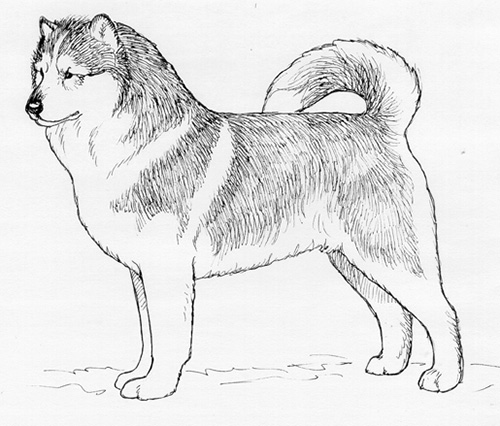stand*ard
noun: standard; plural noun: standards
- a level of quality or attainment.
- an idea or thing used as a measure, norm, or model in comparative evaluations
The Standard — there can be only one
Not really. There are current Standards. There are American Standards (since America is where the first Malamutes were registered). There is the AKC standard — the gold standard, since the AKC was the first to register Malamutes — and also the UKC standard (they are the older registry, but not the largest or the original for Mals). There is the illustrated standard put out by the parent club the AMCA, with all the infighting over each illustration, it is merely a guide. And there is the original 1935 standard.
Wait, original standard? You mean it’s changed?
Of course it’s changed. There are less than a handful of breed standards in the AKC that have NOT changed since inception. Unfortunately or fortunately, depending how you look at it, standards change with the times. But aside from height/weight considerations, the current AKC Mal standard is much the same as the original.

What about those height/weight considerations?
The original 1935 AKC standard called for
- Dogs 22-25″/65-85#
- Bitches 20-23″/50-70#
Well, that’s not that much different is it? The current 1994 AKC standard calls for:
- Dogs 25″/85#
- Bitches 23″/75#
So, yeah, it is that much different. Girls are heavier than they’ve ever been, and what about the range of size which went UP TO the current levels?

That was necessity and politics. After a great loss of life in the Antarctic Expeditions, the AKC Malamute was in danger of genetic dead ends, so the stud books were opened back up to include previously unregistered dogs. And those dogs were a lot bigger than the AKC dogs.
Where did they come from, these new dogs?
Well, it turns out there have always been village dogs and working dogs who went unregistered across Alaska, Canada, & Greenland. Either because their owners didn’t know or care about what the Lower 48 was doing, or because their dogs didn’t look exactly the same as the original founders decided they should look.
This gets into a whole argument about Kotzebue vs. M’Loot, which can be summarized as: There are no pure M’Loot Mals anymore, they’ve been integrated into the original Kotzebue dogs. And their are fewer than a handful of pure Kotzebue dogs left. The vast majority of AKC Malamutes are a blend of those two sets of Malamutes.
Except…
Where did all those unregistered dogs go after the AKC studbooks were closed the second time? They didn’t drop off the face of the planet.
Nope, they are still up there. Some of them are still village dogs, some of them registered now as Canadian Inuit Dogs with the Canadian Kennel Club. Some of them as Greenland Dogs.
- Current 1994 AKC Alaskan Malamute Standard (pdf)
- AMCA 2014 Illustrated Alaskan Malamute Standard
- Current 1991 UKC Alaskan Malamute Standard (pdf)
- Current 1996 UKC Greenland Dog Standard (pdf)
- Current CKC (Canadian Kennel Club) Canadian Inuit Dog Standard
The similarities of these Standards should tell the puppy buyer they all came from the same source — they are all arctic village dogs used for heavy work. But foundation breeders chose specific characteristics (like size and topline, for instance) to differentiate their dogs from the whole village herd of sleddogs. And the lesser-known Greenland Dogs and CIDs are supposed to be larger than AKC Malamutes.

So you got to ask yourself, if a breeder is going to consistently reap the benefits of selling his puppies as AKC Malamutes, he shouldn’t throw out whole sections of the AKC standard for Malamutes. The arguments about “historical” size or “original” Malamutes seem disingenuous when a breeder keeps registering his dogs as AKC Malamutes while they are breeding to the standard for another breed.